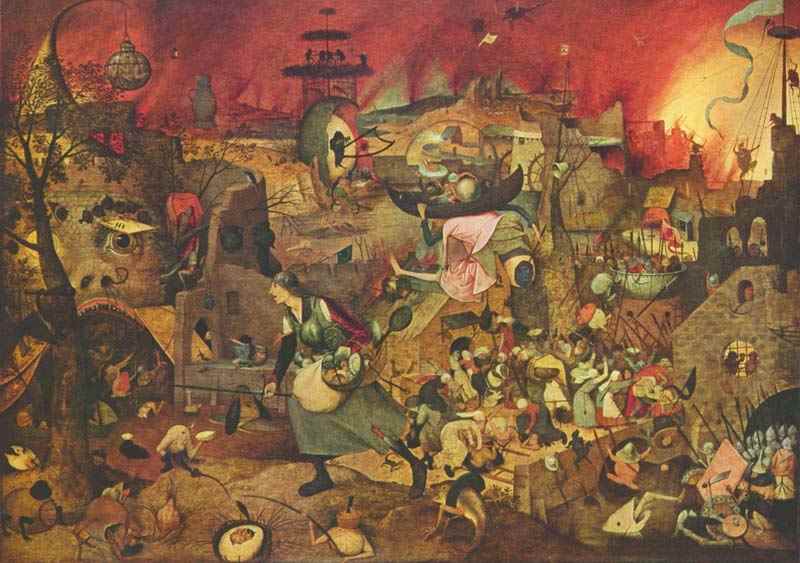
The Dulle Griet (The great Grete). Pieter Bruegel the Elder
1563, oil on wood, 115 × 161 cm
Antwerp, Museum Mayer van den Bergh
---
Die Dulle Griet (Die tolle Grete). Pieter Bruegel d. Ä.
um 1563, Öl auf Holz, 115 × 161 cm
Antwerpen, Museum Mayer van den Bergh
----
. Πήτερ Μπρίγκελ ο πρεσβύτερος
---
Dulle Griet (anglicized as Dull Gret), also known as Mad Meg, is a figure of Flemish folklore who is the subject of a 1562 oil-on-panel by Flemish renaissance artist Pieter Bruegel the Elder. The painting depicts a peasant woman, Mad Meg, who leads an army of women to pillage Hell,[1] and is currently held and exhibited at the Museum Mayer van den Bergh in Antwerp.
History and description
Mad Meg (detail)
Anthropomorphic mouth of Hell with monsters
The signature and the date on this painting are illegible, but its close compositional and stylistic similarity to The Fall of the Rebel Angels and The Triumph of Death, makes it likely that it was painted in about 1562 and destined for a series. Like those pictures, Dulle Griet owes much to Hieronymus Bosch.[2]
Bruegel's earliest biographer, Karel van Mander, writing in 1604, described the painting as "Dulle Griet, who is looking at the mouth of Hell". It came into the collections of Rudolf II, Holy Roman Emperor, then was looted by the Swedish troops in 1648, and reappeared in Stockholm in 1800. Art collector Fritz Mayer van den Bergh discovered it in 1897 at an auction in Cologne, where he bought it for a minimal sum, discovering its actual author a few days later.[3]
Griet was a disparaging name given to any bad-tempered, shrewish woman. Her mission refers to the Flemish proverb:
She could plunder in front of hell and return unscathed.
Bruegel is thus making fun of noisy, aggressive women. At the same time he castigates the sin of covetousness: although already burdened down with possessions, Griet and her grotesque companions are prepared to storm the mouth of Hell itself in their search for more.[4]
Dulle Griet appears as a character in Caryl Churchill's Play "Top Girls" (1982), where she recounts her invasion of Hell: "I'd had enough, I was mad, I hate the bastards. I come out my front door that morning and shout till my neighbors come out and I said, "Come on, we're going where the evil come from and pay the bastards out.'" (Churchill, 28).
Details
While her female followers loot a house, Griet advances towards the mouth of Hell through a landscape populated by Boschian monsters.see detailed images They represent the sins that are punished there. Griet wears male armour - a breastplate, a mailed glove and a metal cap; her military costume is parodied by the monster in a helmet beside her, who pulls up a drawbridge. A knife hangs from her side, while in her right she carries a sword, which may refer to the saying: "He could go to Hell with a sword in his hand." A book of proverbs published in Antwerp in 1568 contains a saying which is very close in spirit to Bruegel's painting:
One woman makes a din, two women a lot of trouble, three an annual market, four a quarrel, five an army, and against six the Devil himself has no weapon.[5]
Notes
Dulle Griet is also the subject of a 1640s painting by Flemish painter David Teniers the Younger.
Cf. Pietro Allegretti. Brueghel. Milan:Skira, 2003. ISBN 0-00-001088-X (Italian)
"Museum Mayer van den Bergh". Museum.antwerpen.be. 2013-11-30. Retrieved 2013-12-08.
Max Seidel, Roger H. Marijnissen. Bruegel. Pt.2, Random House, 1985. ISBN 0-517-44772-X
Cf. The Netherlandish Proverbs: An International Symposium on the Pieter Brueg(h)els, ed. by Wolfgang Mieder. University of Vermont. 2004.
References
Public Domain This article incorporates text from a publication now in the public domain: Chisholm, Hugh, ed. (1911). Encyclopædia Britannica (11th ed.). Cambridge University Press.
External links
W
Dulle Griet at the Museum Mayer van den Bergh
Bosch Bruegel Society
99 works by Pieter Bruegel the Elder
Creative Bruegel laid the foundation of the Netherlands School (Russian)
"Bruegel". Encyclopedia Americana. 1920.
----
Fine Art Prints | Greeting Cards | Phone Cases | Lifestyle | Face Masks | Men's , Women' Apparel | Home Decor | jigsaw puzzles | Notebooks | Tapestries | ...
----
Retrieved from "http://en.wikipedia.org/"
All text is available under the terms of the GNU Free Documentation License


